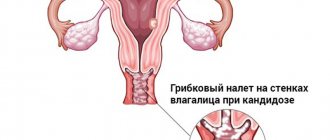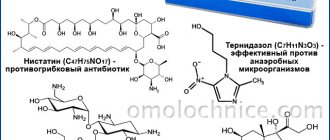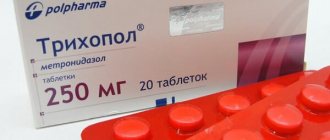Today, a variety of pharmacological drugs represents a line of modern means that reliably and quickly eliminate the causes of fungal infections in the body. Such medications are dispensed from pharmacies without a prescription or as prescribed by a doctor. When following the prescribed regimen of therapeutic actions, this group of antimycotic drugs fully confirms expectations.
Tablets for thrush have a high level of demand among patients, as they have a systemic effect on the body, preventing the possible development of relapses of the disease. This group of drugs represents a wide range of antimycotic effects, having, in most cases, a convenient daily dosage in one tablet.
Why can thrush appear in a sexual partner?
The fungus that causes thrush, Candida albicans, normally colonizes the vagina in 80% of women. This is a conditionally pathogenic microorganism, which, under certain unfavorable conditions, begins to actively multiply and penetrate the mucous membrane. This causes unpleasant and painful symptoms.
During sexual contact, “aggressive” microflora enters the partner’s genitals and in 99% of cases initiates symptoms of thrush. Provided it is pathogenic, Candida is equally dangerous for both women and men.
Vaginal residents
However, mushrooms are not permanent and not the predominant representatives of the vaginal fauna. Now I wrote this word and thought: I wonder why, when we talk about microbes, they say microFLORA? After all, “flora” is plants, and “fauna” is animals. Or are microorganisms more like plants?
Well, God be with them. Go ahead.
The main inhabitants of the vagina are lactobacilli. They make up more than 90%.
Bifidobacteria and opportunistic microbes also live here in minimal quantities: gardnerella, mycoplasma, streptococci, staphylococci, anaerobes, etc.
Lactobacilli perform a very important function: they protect the vagina from external microorganisms, restrain the excessive reproduction of “neighbors” and prevent them from going all out.
Symptoms of candidiasis
Symptoms of thrush cause concern to each of the partners. They usually appear within 24 hours after sexual intercourse and can last up to a week or more. In some cases, the symptoms go away on their own, but often from the first days they cause significant discomfort, which makes the recovery process impossible without drug therapy.
In men
The manifestation of thrush is in many ways similar to female symptoms, but most often the intensity of their manifestation is much less.
It could be:
- redness of the glans and foreskin;
- itching, possibly a slight burning sensation when urinating;
- the appearance of a whitish coating on the head and in the folds of the foreskin.
Among women
The gynecologist determines how to treat thrush in women based on the anatomical features and clinical picture. The structure of the genital organs favors the progressive development of the disease. In this case, recovery requires longer treatment than in men.
Most common symptoms:
- itching and burning in the external genital area;
- redness of the outer labia;
- curdled vaginal discharge. In some cases, they acquire an unpleasant odor.
Risk group
Most experts agree that thrush in a man develops exclusively after unprotected sexual contact with an infected partner. Such statements are only half true. The fact is that if a man’s protective functions of the body are not weakened, then he can independently cope with the fungal microflora, suppressing it and preventing the development of the disease.
Infection occurs only when the following predisposing factors affect the male body:
- Diseases of the gastrointestinal tract, anemia and hypovitaminosis.
- Excessive body weight and increased sweating.
- Dysfunctions of metabolic processes and diabetes mellitus.
- Long-term use of antibacterial drugs and corticosteroids.
- Alcohol abuse.
- Stressful situations and emotional overload.
Diagnosis of thrush
A gynecologist for women, or a urologist for men will help determine the disease and prescribe adequate treatment.
The conclusion is made based on:
- studying patient complaints - describing the intensity and duration of symptoms. Identification of previous factors for the occurrence/exacerbation of candidiasis;
- examination of the condition of the genital organs;
- taking a smear. The sample is examined by microscopy, culture, or another method necessary in each specific case.
In the acute form of thrush, the symptoms are usually objective. With chronic candidiasis in women, itching, inflammation and heavy discharge may be absent.
Despite this, pathological changes occur in the vagina - atrophy, tissue infiltration by fungal mycelium, and proliferation of connective tissue fibers. Due to the high risks of this disease in women, an annual examination by a gynecologist is indicated.
What are the medications for thrush?
They include azoles, polyene antibiotics, iodine preparations and other drugs. They differ in the specificity of action, the presence of side effects and the speed of reaction.
Antifungal drugs – azoles
These are substances that inhibit the synthesis of fungal membrane components. They are more effective than polyene antibiotics.
There are:
- imidazole derivatives. Second generation drugs. The most famous are clotrimazole, ketoconazole and butoconazole. Release forms: vaginal and oral tablets, cream. Butoconazole is an emulsion with bioadhesive properties. A single application of the drug to the vagina can eliminate the symptoms of acute candidiasis;
- triazole derivatives. Third generation drugs. The most effective representatives of the series are fluconazole and itraconazole. Powerful inhibitors of ergosterol synthesis, they remain in the body for a long time, which allows reducing the treatment period to 3 days.
Polyene antibiotics
How to treat thrush in women has been known since the end of the 19th century. One of the first drugs used to treat local and systemic mycosis.
Frequently used:
- nystatin - known since the 50s. XX century. Used for complex therapy of thrush. Use intravaginally and orally. Due to poor absorption in the gastrointestinal tract, the course of treatment lasts on average 10-15 days. At the same time, 500 thousand units are taken per day from 4 to 8 times. In the form of suppositories, the dose is less - 100 thousand units. They need to be administered up to 2 times a day for 7-14 days. The tablet form is absorbed by only 3-5% of the original amount of the substance. Non-toxic;
- levorin - presented in the form of tablets and ointments. Take 500 thousand units orally 3-4 times a day for 10-15 days. It is not as widely used as nystatin due to its high allergenicity and harmful effects on the gastrointestinal tract and liver. Contraindicated during pregnancy;
- amphotericin B is an effective polyene for the treatment of systemic candidiasis. It is not used to treat thrush due to the high likelihood of side effects;
- natamycin (pimafucin) is the most effective polyene antibiotic among the entire series. Inhibits the vital processes of the fungus by introducing into its shell. Due to low bioavailability, intravaginal forms are prescribed - 100 mg at night for a week. Or ointment - 2-3 times a day, apply a thin layer to the vaginal walls. Non-toxic. Allowed during pregnancy.
Povidone-Iodine
This is a two-component drug with a pronounced antimicrobial effect. It suppresses the vital functions of not only fungi, but also bacteria, viruses, and protozoa. Polyvinylpyrrolidone in the composition of Povidone-iodine doses the release of free iodine elements, providing a stable concentration in the area affected by mycosis.
Active damage to the cell membrane occurs within the first 15-30 seconds after application of the drug. After this, iodine loses its color, which indicates a decline in the mycocidal effect.
This drug is available under various trade names in the form:
- antiseptic solutions;
- aerosols;
- vaginal suppositories;
- ointments.
For the treatment of acute or chronic candidiasis, use 1 suppository 1-2 times a day. Course – 7-14 days. Povidone-iodine can also be used to prevent infectious diseases of the genital organs. To do this, you need to put 1 candle at once, then 1 candle for 3-4 days.
Combination drugs that contain antibiotics and hormones
In later stages of candidiasis, when bacterial infection has joined the disease, the use of combination drugs is appropriate.
They have not only a fungicidal, but also a bactericidal effect:
- Terzhinan. In addition to antibiotics and antimycotics, it contains a synthetic steroid hormone that relieves inflammation and reduces tissue swelling. Presented in the form of vaginal tablets;
- Polygynax. Release form: vaginal capsules. Neomycin and polymyxin have an inhibitory effect on pathogenic bacterial flora, contributing to its destruction. Nystatin suppresses the activity of fungi;
- Ginalgin. Presented in the form of vaginal tablets. The combination of metronidazole and chlorquinaldol has a pronounced antimicrobial effect, affecting not only fungi, but also bacteria and protozoan microorganisms;
- McMiror complex. Available in the form of cream and suppositories. The mutual enhancement of nifuratel and nystatin effectively destroys fungi, bacteria and trichomonas. Not absorbed into the blood.
Borax in glycerin 5–10%
Whatever the cause of thrush in women, treatment with this drug is strictly not recommended. It has high toxicity and a number of side effects. In some cases, it is used as an aseptic agent applied to the skin and mucous membrane.
Pills for men
Antifungal medications for men have the same list as for women, presenting thrush tablets for both. Conservative actions with their use include eliminating the immediate cause of candidiasis, since another direction of treatment will be ineffective in relation to yeast-like lesions of the mucous membranes.
The dosage and course of taking a particular drug are prescribed by the doctor, after conducting diagnostics and obtaining laboratory confirmation of the presence of an excessive amount of fungal representatives in the area of inflammation. This approach allows you to most quickly, taking into account the minimum dosage, obtain the result of complete recovery.
The most popular drugs for the treatment of male candidiasis are:
- Flucostat. It is a synonym for Fluconazole, having the same active ingredient in its composition. Effectively relieves unpleasant symptoms by inhibiting the growth and reproduction of fungal flora. Its cost is 190 rubles/250 UAH.
- Fluconazole. The drug has an affordable price level combined with high effectiveness in curing thrush. It is quickly absorbed and transported to the site of fungal infection, where it is absorbed and accumulated by tissues, suppressing the activity of the pathogen with its subsequent death. The capsules have the dosage of the daily requirement for the drug, namely 150 mg. There is also a release form of 50 mg, in which case you need to take 3 capsules at a time. The price of the medicine is 35 rubles/13 UAH.
- Pimafucin. This is a representative of macrolides, which includes natamycin with a dosage of 100 mg. The effectiveness of treating candidiasis using this remedy provides a quick result with a remission-resistant effect. Its side effects on the body are minimal; it does not carry any additional toxic load. The treatment regimen consists of 4 doses per day, ranging from a week to 10 days. The cost of the drug is 415 rubles/50 UAH.
- Nystatin. Used for early diagnosis of the disease or its mild form. The drug is low-toxic, non-addictive, while simultaneously inhibiting the vital activity of the fungal pathogen. There is no need to crush the tablet before taking it, but you should wash it down with some liquid. The price of the medicine is 22 rubles/9 UAH.
The treatment process using effective tablets for thrush is quite simple, representing a single dose per day, while at the same time having high rates of rapid recovery of the body against the background of existing fungal infections of different stages and intensity of development. The course of treatment measures is determined individually, in accordance with the current characteristics of the pathological disorder.
Systemic drugs for candidiasis for both partners
In some cases, antifungal therapy with local drugs does not produce a positive effect and the disease becomes chronic.
One of the reasons could be:
- premature completion of the course of treatment. With timely treatment of acute candidiasis, the main symptoms may disappear on the 3rd day. However, the duration of effective use of intravaginal drugs is on average 7-14 days. As a consequence of incomplete treatment, a relapse in the future or the acquisition of a chronic form of thrush;
- discomfort. Ointments and suppositories can leave noticeable marks on laundry, and some medications can leak significantly. Regular use of suppositories requires compliance with certain conditions, which for some women can negatively affect the quality of life;
- emergence of Candida drug resistance. The pathogen quickly “gets used” to topical drugs;
- penetration of the pathogen into the bloodstream. When the body's protective barrier is reduced, the mycelium of the fungus is able to penetrate through the epithelial layer deep into the tissues. It can be found in all environments and human organs;
- systemic disease. The primary localization of infection is associated with other organs and systems.
This gives grounds for the use of systemic drugs, which is convenient for both women and men.
Azoles of systemic influence
In modern medical practice, preference is given to third-generation azoles - fluconazole and itraconazole. These are triazole derivatives. They are not toxic, and candida practically does not develop resistance to them. An exception is long-term treatment of esophagitis in HIV-positive patients and stomatitis caused by Candida fungi.
The drugs are available in the form of tablets or capsules for oral use. Triazoles are well absorbed from the gastrointestinal tract. The rate of absorption of most of them depends on the state of the stomach environment. The exception is fluconazole - it is absorbed equally, regardless of food intake and time of day.
The half-life of azoles is from 8 hours. This increases the effectiveness of treatment compared to other types of drugs and speeds up the recovery period. Itraconazole and other azoles are excreted through the liver and gastrointestinal tract. Fluconazole – through the kidneys.
How to treat thrush in women and men:
- Fluconazole – 150 mg (one capsule) once for acute manifestations of candidiasis in one of the partners. For prevention purposes - 150 mg every 3rd day for a week and then every 7 days for 6 months;
Fluconazole is how to treat thrush and nail fungus in women and men
- Itraconazole – 200 mg per day once or divided into two doses. In the absence of infection by other types of microorganisms, treatment takes from 1 to 3 days.
Polyene antibiotics
This group of antimycotics has a wider spectrum of action than azoles. However, they are poorly absorbed from the gastrointestinal tract. The best use is intravenous. Unlike azoles, they act not only by slowing down the growth of fungi, but also lead directly to their death.
For severe systemic diseases, amphotericin B is more often used - it is quite effective, but is highly toxic. Frequent side effects are diarrhea, nausea, vomiting, allergic manifestations.
In this regard, a new, less toxic form of the drug was developed - liposomal amphotericin B. Its advantage is also reduced intactness to healthy tissues. Only when it enters infected environments does it begin to interact directly with the affected areas.
Mode of application:
- Nystatin - tablets are available in doses of 250 and 500 thousand units. Take 1-2 tablets twice a day. The course is from 7 to 14 days depending on the etiology of the disease;
- Levorin – tablets of 500 thousand units. Prescribe 1 tablet up to 4 times a day. Course from 7 to 12 days;
- Natamycin (pimaf ucin) – 1 tablet 4 times a day. Course – up to 7 days. Allowed for children over 3 years old.
Candida Clear (caprylic acid)
The food supplement produced by Now Foods – Candida Clear is developed on the basis of phytocomponents:
- caprylic acid, 500 mg;
- Pau d'Arco tree bark extract, 300 mg;
- black walnut extract, 300 mg;
- oregano oil, 200 mg;
- magnesium, 45 mg;
- biotin, 2 mg.
The main active substance is caprylic acid. It is a derivative of coconut oil, but small concentrations are found in breast milk and cow's milk.
It inhibits fungal microflora and reduces inflammation of the mucous membrane. The drug is taken 2 times a day, 2 capsules with meals.
What do you need to remember?
- Thrush is a fungal disease that is not sexually transmitted.
- Thrush should be treated by both partners, even if one of them shows no signs of the disease.
- During therapy, antifungal drugs are used for local and systemic effects.
- Local remedies for women: suppositories and vaginal tablets, for men: creams.
- In addition to antifungal agents, the use of probiotics and vitamin complexes is recommended.
- In case of repeated relapses of thrush, laboratory diagnostics are carried out to determine the sensitivity of the fungi to the action of the active component of the drug.
Literature:
- Ankirskaya, AC Genital candidiasis in the structure of opportunistic infections of the vagina. Principles of laboratory diagnostics and the importance of monitoring the sensitivity of fungi to antimycotics / A.S. Ankirskaya,
- Veselov, AB In vitro activity of fluconazole and voriconazole against more than 10,000 yeast strains: results of a 5-year prospective study of ARTEMISK Disk in Russia / AB Veselov, HH Klimko, O.I. Krechikova [and others] // Clinical. microbiology and antimicrobial, chemotherapy. -2008. — No. 4 (10). — P. 345-354.
- Bayramova, G.R. Candidiasis infection. Polyene antibiotics in the treatment of vaginal candidiasis / G.R. Bayramova // Gynecology. - 2011. - T. 3, No. 6. -S. 212-214.
- Veselov, V. Systemic antimycotics: status and prospects / AB Veselov // Clinical. microbiology and antimicrobial, chemotherapy. - 2007. - T. 9, No. 1.-S. 73-80.
- Dolgo-Saburova, Yu.V. Clinical and laboratory features of chronic recurrent genital candidiasis in women dis. ...cand. honey. Sciences / Yu.V. Long-Saburova. - St. Petersburg, 2006. - 26 p.
- Leshchenko V.M. Laboratory diagnosis of fungal diseases. - Moscow, 1977.
- Vasilyeva N.V. Sensitivity of Candida species to fluconazole and some of its generics in in vitro tests. / Problems of medical mycology, 2002, vol. 4, no. 2, p. 43 44.
- Evidence-based medicine for sexually transmitted infections (annual guide). Moscow, 2003, p. 1698 - 1760.
- Loan O.B., Sinyakova L.A., Kosova I.V. Uncomplicated urinary tract infections: problems of choosing rational antimicrobial therapy. / Pharmateka. 2004, No. 11, p. 65 - 68.
- Mirzabalaeva A.T. Features of the clinical course of chronic recurrent genital candidiasis caused by strains of Candida fungi resistant to isolated drugs. / Advances in medical mycology, Moscow, 2005, vol. VI, p. 161-163
Review and prices of ointments for the treatment of candidiasis in men and women
Since acute manifestations of thrush in men are less common than in women (2-3% of cases), medications in the form of ointments and creams are suitable for treatment.
Clotrimazole
A drug with the same active ingredient, an imidazole derivative. Acting locally on the mucous membranes, it is practically not absorbed into the blood. Clotrimazole has a wide spectrum of effects, inhibiting the vital activity of not only Candida fungi, but also Leishmania, Trichomonas and many yeasts and molds.
In this case, the fungicidal effect is predominantly on Candida when directly applied to the affected area. There are release forms for both women and men (shown in the table below).
| Release form | For whom | Dose, method of application | Price |
| Cream/ointment 1% | Women, men | 2-3 times/day for 1-2 weeks | 50-200 rub. depending on the manufacturer (India, Germany, Poland) |
| Cream 2% with applicator | women | 100-500 mg (full applicator) at night, for 6 days | 200-240 rub. |
| Solution 1% | Men, women | 2-3 drops, rubbing evenly over the infected area. Course – 2-4 weeks | 210 rub. |
A specialist will help you determine how to treat thrush in women. If external symptoms do not disappear during the first week of treatment, additional consultation with a gynecologist/urologist is necessary. You may need to change your medication.
Pimafucin
Presented in the form of a cream with 2% natamycin content. This is a polyene antibiotic that has a bacteriostatic effect - in small doses, and a fungicidal effect - when the drug is applied generously.
The duration of the course for men depends on the clinical manifestations of thrush and can be from 6 to 10 days. For chronic and recurrent vulvitis in women, local therapy is supplemented with systemic therapy. Apply the cream to a clean and dry area of skin 1-4 times a day. The average cost of Pimafucin is 220-300 rubles.
Nystatin
It is produced by Streptomyces noursei. It is active mainly against yeast and yeast-like fungi, including Candida. It acts strictly locally, penetrating into internal environments only by 3-5%. With long-term treatment, there is a minimal risk of the pathogen developing sensitivity to it. Does not have cumulative properties.
Nystatin is available in a dose of 100 thousand units. It should be applied in a thin layer 1-2 times a day. The average course duration is 7-10 days. Contraindicated for pregnant women and children. The average cost is 35-75 rubles.
Econazole
Azole group drug. It has a wide range of effects on pathogenic microflora. It has not only a fungicidal but also a bactericidal effect. It is also produced under the trade names: Gino-pevaril, Econazol-Pharmex, Ecodax.
Apply to affected skin and/or mucous membranes 1-2 times a day. The course lasts on average up to 2 weeks. Price from 80 rub.
Candide
The active ingredient is clortimazole. Its content in the tube is 1% of the total mass. Used for infections of the vulva in women and balanoposthitis in men 2-3 times a day for 1-2 weeks. Candide B is also produced, containing in addition to clotrimazole, beclomethasone.
This component helps to more effectively eliminate itching and burning, as well as suppress allergic and inflammatory reactions. Allowed for children and pregnant women. Cost – from 80 rubles.
The choice of one or another antifungal drug depends on many factors - the etiology of the disease, the presence of contraindications, the severity of the condition. Therefore, treatment of thrush in women must begin before it becomes chronic.
Author: Pavlova Maria
Article design: Vladimir the Great
Features of treatment
Thrush is not a sexually transmitted disease. Most people mistakenly classify it as a sexually transmitted disease due to the similarity of the symptomatic picture. Why do you need to treat thrush at the same time? A woman infected with a pathogenic fungus can pass it on to her husband. In representatives of the stronger sex, thrush may not show pronounced symptoms, but the husband can again infect his wife. The rules for treating the disease, regardless of the patient’s gender, are as follows:
- pass medical tests;
- restore microclimate and acidity on the mucous membrane;
- normalize the protective functions of the immune system;
- treat concomitant diseases.










